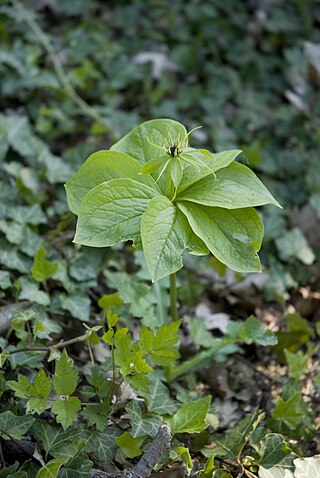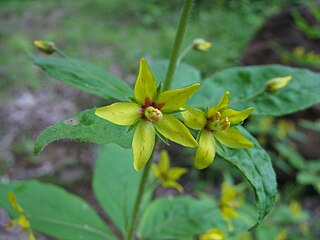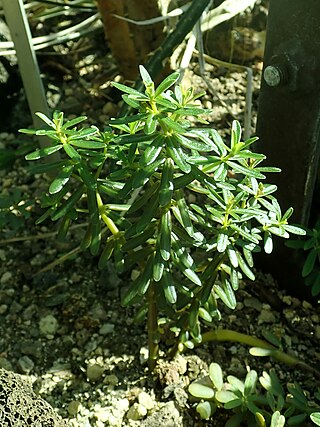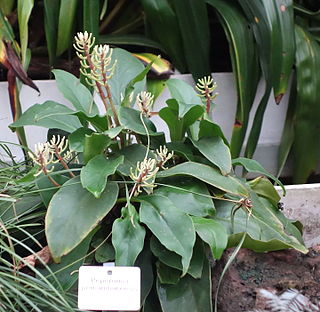
Peperomia is one of the two large genera of the family Piperaceae. It is estimated that there are at least over 1,000 species, occurring in all tropical and subtropical regions of the world. They are concentrated in South and Central America, but may also be found in southern North America, the Caribbean islands, Africa, Oceania, and southern and eastern parts of Asia. The exact number of species is difficult to determine, as some plants have been recorded several times with different names, and new species continue to be discovered. Peperomias have adapted to many different environments and their appearances vary greatly. Some are epiphytes or lithophytes, and many are xerophytes or possess underground tubers (geophytes). Most species are compact perennial shrubs or vines.

Trilliaceae was a family of flowering plants first named in 1846; however, most taxonomists now consider the genera formerly assigned to it to belong to the family Liliaceae. The APG IV system, of 2016, does not recognize such a family either and assigns the plants involved to family Melanthiaceae, tribe Parideae.

Pinus quadrifolia, the Parry pinyon, is a pine in the pinyon pine group native to southernmost California in the United States and northern Baja California in Mexico, from 33° 30' N south to 30° 30' N. The Parry pinyon has a lifespan of around 200 to 500 years. It is usually found in rocky areas that often have thin soil. It occurs at moderate altitudes from 1,300 metres (4,300 ft) to 1,800 metres (5,900 ft), rarely as low as 1,200 metres (3,900 ft) and as high as 2,500 metres (8,200 ft). It is scarce and often scattered in this region, forming open woodlands, usually mixed with junipers. Other common names include nut pine and fourleaf pinyon pine.

Paris quadrifolia, the herb Paris or true lover's knot, is a species of flowering plant in the family Melanthiaceae. It occurs in temperate and cool areas throughout Eurasia, from Spain to Yakutia, and from Iceland to Mongolia. It prefers calcareous soils and lives in damp and shady places, especially old established woods and stream banks.

Peperomia graveolens, commonly known as Ruby Glow, is a species of plant in the genus Peperomia of the family Piperaceae. It is endemic to Ecuador.

Marsilea quadrifolia is a herbaceous plant found naturally in central and southern Europe, Caucasia, western Siberia, Afghanistan, south-west India, China, Japan, and Vietnam, though it is considered a weed in some parts of the United States, where it has been well established in the northeast for over 100 years. Its common names include four leaf clover and European waterclover (USA).

Lysimachia quadrifolia, the whorled loosestrife, whorled yellow loosestrife, or crosswort, is a species of herbaceous plant in the family Primulaceae. It native to the eastern United States and Canada.

Peperomia pellucida is an annual, shallow-rooted herb, usually growing to a height of about 15 to 45 cm, it is characterized by succulent stems, shiny, heart-shaped, fleshy leaves and tiny, dot-like seeds attached to several fruiting spikes. It has a mustard-like odor when crushed.

Peperomia tetraphylla, known as the acorn peperomia or four-leaved peperomia, is a small plant in the Peperomia genus and the Piperaceae family that grows natively in tropical and subtropical regions around the world. Additionally in can found on Easter Island as an introduced species.

Asclepias quadrifolia, commonly called four-leaved milkweed or fourleaf milkweed, is a species of milkweed in the Apocynaceae (dogbane) family. It is sometimes referred to as whorled milkweed, but it should not be confused with Asclepias verticillata. A. quadrifolia occurs in the eastern United States and Canada.

Peperomia obtusifolia, also known as the baby rubberplant, American rubber plant, or pepper face, is a species of flowering plant in the genus Peperomia under the family Piperaceae, native to Florida, Mexico and the Caribbean. The specific epithet obtusifolia means "blunt-leaved". The plant has gained the Royal Horticultural Society's Award of Garden Merit.

Peperomia galioides is a species of plant in the family Piperaceae, native to Mexico, Central America and South America. P. galioides has petioles of less than 1mm long and leaves between 5-30mm. There has been research in Colombia and Peru to know about the essential oils of this species. It was traditionally used in Peruvian herbal medicine.

Peperomia pernambucensis is a species of plant in the genus Peperomia in the family Piperaceae. Its native range is in Central and South America from Nicaragua to Bolivia.
The anthophytes are a grouping of plant taxa bearing flower-like reproductive structures. They were formerly thought to be a clade comprising plants bearing flower-like structures. The group contained the angiosperms - the extant flowering plants, such as roses and grasses - as well as the Gnetales and the extinct Bennettitales.

Peperomia serpens, the vining peperomia, is a species of flowering plant in the genus Peperomia and family Piperaceae, native to the New World Tropics. The plant is perennial.

Peperomia nitida is a species of plant in the genus Peperomia. Its native range is in South America from Brazil to northern Argentina. It can be kept as a houseplant and is sometimes sold as cupid peperomia, or problematically as Peperomia scandens or Peperomia serpens.

Peperomia boivinii is a species of plant in the genus Peperomia of the family Piperaceae. It is endemic to the Comoro Islands situated between the southeastern coast of Africa and Madagascar. It is sometimes called the jade peperomia.

Peperomia glabella, commonly known as the cypress peperomia or wax privet, is a species of plant in the genus Peperomia of the family Piperaceae. Its native range is from southern North America to central South America. Three varieties are known. In addition to the basic one they are P. glabella var. nudipetiolata and P. glabella var. obtusa (Steyerm.).

Peperomia orba is a species of plant in the genus Peperomia of the family Piperaceae.

















